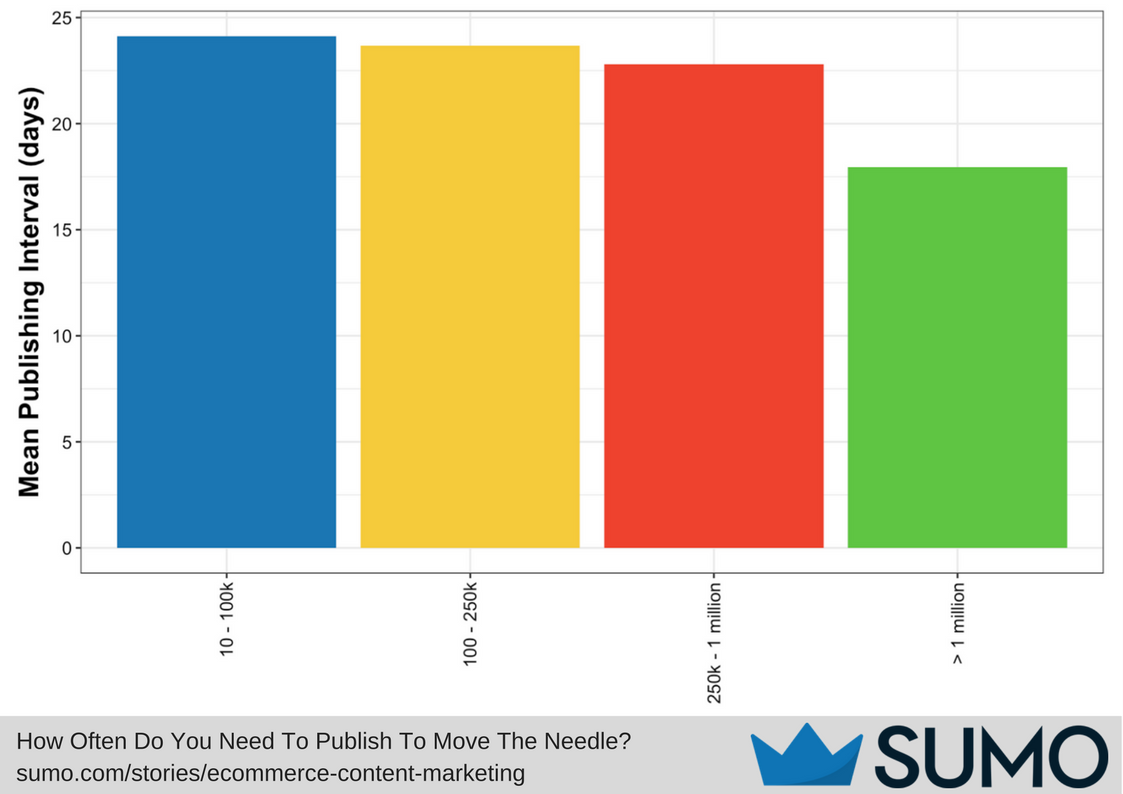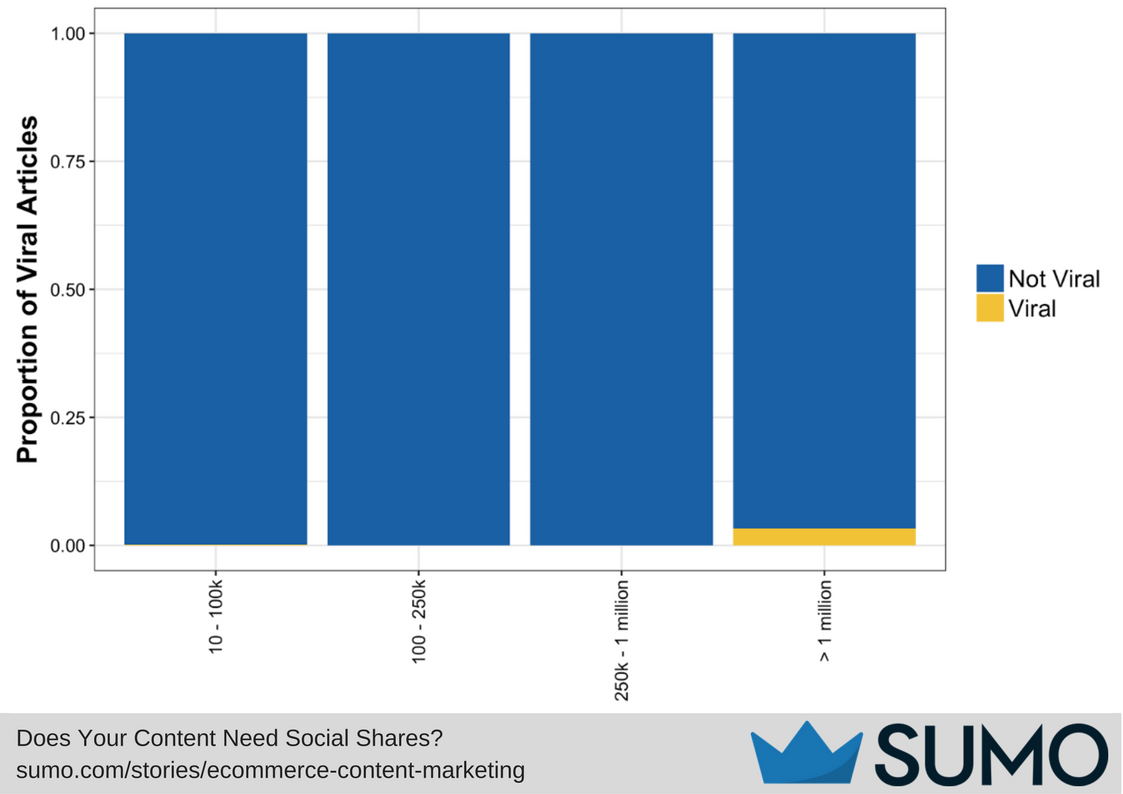There’s a common assumption that content marketing is for blog-only sites or SaaS businesses.
There’s no way it can work for your eCommerce business, right?
Wrong.
We analyzed the content marketing efforts of 88 Sumo customers in four revenue categories as reported to Sumo — from businesses that make $10,000 a year, to businesses that make over $1 million a year. That meant we had almost 7,000 articles to help answer some burning questions:
%(tableofcontents)
All of the data were queried from a public source and then analyzed using R (statistical software). Before you try this yourself, know that we had to clean up the data a lot before working with it.
There are many forms of content marketing eCommerce businesses can do, including podcasts, blog posts, and videos. In this guide, we’re diving deep into one type: blog posts.
Here’s what we found.
Not a fan of long-form blog posts, read slides instead.
#1: Do Million-Dollar Companies Do Content Marketing Differently?
The first question we wanted to answer was whether higher earning companies publish more content than less profitable ones. Unsurprisingly, the answer is yes.
Here are the annual revenue categories we analyzed (n = number of companies):
- $10K-$100K (n = 40)
- $100K-$250K (n = 16)
- $250K-$1 million (n = 16)
- $1 million or more (n = 16).
And here’s what we found…

eCommerce companies in the three highest revenue categories seem to publish more articles per year. They all published close to 30 articles per year (yellow, red, and green bars), while companies in the lowest revenue category (blue bar) published, on average, 20 articles per year.
For example, Kettle and Fire (who is in the over $1 million category) published more than once per week on their blog over the past year, and they have 204 articles live right now.

Compare that with a business in a lower-revenue category which only has four articles published in the past year:

It’s possible that the companies in the lower revenue categories are newer, and are still catching up to the bigger guys in terms of the amount of content published.
Key takeaway: If you’re a new eCommerce business or just want to scale your revenue, this data suggests that you should take content marketing very seriously and publish more articles.
#2: Do Backlinks Really Affect Content Marketing Success?
Backlinks are a metric that’s been coveted and obsessed over almost since the start of search engines.
The theory is that backlinks give a site authority, helping it to land on the first page for key search terms, which in turn can bring your business loads of free traffic and sales.
So did we find that to be true?
Yes!

In our analysis, companies in the over $1 million revenue category had a higher mean number of backlinks per article than those in lower revenue categories.
(And remember, while these numbers look small, their effect, when multiplied over hundreds of articles translates into a lot more backlinks to their sites).
Interestingly, companies in the first category (blue bar – less than $100k/year) did better than the next category (yellow bar). It could be that those sites are newer and are run by owners who are better educated about SEO ranking factors. But we can’t say for sure.
So, bigger companies have more backlinks. This makes sense.
Research from SEMRush in 2017 supports this idea that backlinks are one of the strongest ranking factors. And it determined that “2.2 times more backlinks lead to URLs on the first position than to the URLs on the second”.[*]
Sounds like a chicken or the egg question, right? What came first? Is it:
- The backlinks are making the articles rank better in Google and therefore getting more traffic and sales? Or…
- The ranking in Google or the excellent content (linkable assets) generating more backlinks?
I’m guessing the latter. And the data seems to agree:

We found that “viral content” (defined for our purposes as articles with over 2,000 shares) have way more backlinks compared to non-viral content — just over 23x more backlinks to be exact.
So what does this mean?
Well, it seems that social shares come first, then the backlinks. Not the other way around (because there’s no logic in Google rank affecting social shares).
Or in other words, people don’t share content because it ranks well. People share content because it’s good content and therefore they link to it.
For example, this is the most shared article that Bulletproof published in the past year:

This article has raked in 64,000+ shares and 63 backlinks (live index from Ahrefs).
On the other hand, the most shared article of one of the lower revenue category companies has only 184 shares and no backlinks.

This supports the idea that you should worry less about building backlinks, and instead focus on creating epic content (that will naturally attract links and shares).
Note: Backlink numbers can sometimes be inflated by footer links and other factors.
Key takeaway: Create “linkable assets”: Amazing content for your eCommerce site that people want to share and link to.
#3: How Often Do You Need To Publish To Move The Needle?
Content marketers get into this debate far too frequently: Is it better to publish more often or publish less often?
Using the million-dollar companies as a benchmark, it’s safe to say that publishing more often is better:

This bar graph shows the mean publishing interval in days. That is, it shows how long the companies in each revenue category generally go between publishing a new article. So, the shorter the bar, the more often the group published.
We found the publishing interval to be shortest in the highest revenue category.
On average, $1 million companies publish every 18 days, whereas businesses making less than <$100K publish every 24 days.
This makes sense because the more content you publish, the more search terms you have the opportunity to rank for, and the more your authority on a topic builds.
For example, Perfect Keto publishes 5-6 times per week, and they rank for 50.3K keywords, according to Ahrefs:

Whereas this company (in the $10-100K revenue category) publishes on average less than one article per week and only ranks for 2.7K organic keywords:

The interesting part? The anonymous company above has been around for longer than Perfect Keto (by a couple of years).
This isn’t a debate about whether quantity is better than quality. They’re not mutually exclusive. If you have the budget for content marketing, you can (and should) publish great content, more frequently.
Key takeaway: The highest revenue-generating companies publish more often; every 18 days compared to 24 days.
#4: Does Your Content Need Social Shares?
Last year our readers told us they wanted to learn how to get more social shares on their articles. Yet for eCommerce businesses, social shares may not drive sales as much as you think.
We found that it was extremely rare for an article published by an eCommerce site to truly go viral (we’re talking 50k+ shares).
For our analysis, we set the bar lower at 2,000 shares or more, and this is what we found:

This suggests that social shares don’t matter that much for profitable eCommerce content.
It’s likely that this is because the traffic to the content on these popular eCommerce sites comes from search engines rather than social networks.
So instead of chasing after social shares in hopes to drive more traffic to your content, an SEO strategy may serve you better. Focus on targeting keywords that your customer will be searching for, and creating content to help them.
Key takeaway: Focus on creating content that helps your customer, and not on content that tries to get social shares.
#5: How Long Do Your Articles Need to Be?
Probably the most common question a content marketer gets is how long a blog post should be.
Most people hate the real answer (“as long as it needs to be to be valuable, and no longer”) because it’s vague and we’ve all heard conflicting opinions.
- “Long-form content gets more social shares than short content and ranks better in search engines!”[*]
- “Nobody has the attention span for long-form content anymore. Your articles should be 500 words or less!”
But which sells more?
To answer this, we looked at the mean word count of articles published by companies in the four different revenue categories:

We found that million-dollar companies seem to publish slightly longer articles (in the 1,250-word range; green bar), while other groups published fewer words per article (somewhere between 890 and 1050 words (blue, yellow, and red bars).
While we can’t be sure (from this analysis) that longer content sells more, chances are pretty good that big companies aren’t just wasting their time and money by writing longer articles. It’s a good bet they know content marketing works and are building their empire one word at a time.
Key takeaway: The most successful companies write longer content (in the range of 1,250 words per article).
The Most Successful eCommerce Companies Do Content Marketing Differently
Seth Godin said, “content marketing is the only marketing left”.
Instead of thinking you should push out a bunch of short, 300-word blog posts and hunt for backlinks to prove to Google your content is worth ranking, emulate what the million-dollar businesses are doing.
Seven-figure companies:
- Have more pieces of content online
- Publish more frequently
- Create quality content that naturally attracts shares, and then backlinks
- Focus on organic keyword opportunities, not clickbait for social traffic
- Publish longer content.
In other words, they invest in content marketing because they know it pays dividends. And so should you.
Add A Comment
VIEW THE COMMENTS